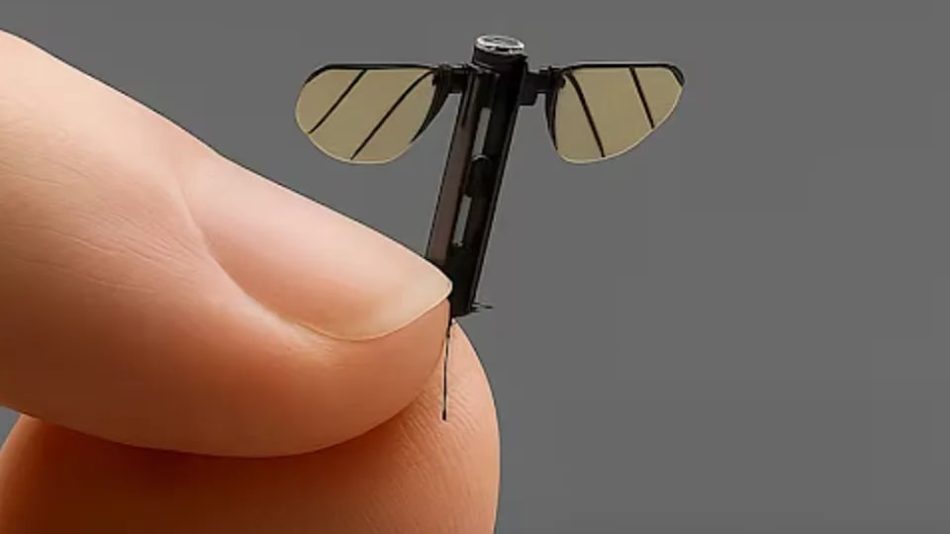A research team at China’s National University of Defense Technology (NUDT) has developed a remarkable mosquito-sized microdrone, a cutting-edge tool designed for reconnaissance and covert battlefield operations.
This development, revealed by state broadcaster CCTV in a recent military-focused report and covered by the South China Morning Post, represents a notable advancement in miniaturized autonomous systems. The drone, showcased on CCTV-7, is so small it can be held between two fingers, featuring leaf-shaped wings and threadlike landing gear that give it a delicate, insect-like appearance. Liang Hexiang, an NUDT student involved in the project, described it as a “mosquito-like bionic robot,” emphasizing its purpose-built design for special missions and information gathering.
This tiny aerial vehicle could potentially transform how militaries conduct discreet surveillance in complex environments, though its practical deployment remains unconfirmed by Chinese authorities. Creating a drone of this size is no small feat. The technical challenges are immense, requiring the integration of power systems, sensors, control circuits, and advanced materials into a microscopic frame. Drawing on progress in microdevices, bionics, and materials science, the NUDT team has equipped the drone with ultra-small cameras and microphones capable of capturing images, sound, and even electronic signals.
These features make it particularly suited for covert reconnaissance missions, where larger, more noticeable drones would be impractical or easily detected. The effort reflects a blend of innovation and precision, pushing the boundaries of what’s possible in drone technology. This mosquito-sized platform isn’t entirely unique in the world of micro unmanned aerial vehicles (UAVs). It shares similarities with other globally developed systems, such as the Norwegian-built Black Hornet, a palm-sized reconnaissance drone now in its fourth iteration, and Harvard’s experimental “RoboBee,” which boasts the ability to both swim and fly.
These comparisons reveal a broader trend in military technology, where compact, agile surveillance tools are increasingly valued for their ability to navigate tight spaces or high-risk areas without drawing attention. The NUDT microdrone fits squarely into this movement, signaling China’s active participation in the global race to refine battlefield robotics. While the Chinese military has not yet confirmed whether this drone has been deployed in the field, its public demonstration points to a sustained investment in shrinking autonomous systems—a priority echoed by militaries worldwide.
The potential applications of such a tiny drone are intriguing, particularly for specific scenarios. Herb Lin, a senior research scholar at Stanford’s Center for International Security and Cooperation, suggested to Business Insider that it could be “quite useful for video feeds” when surveilling buildings, especially their interiors. This capability could prove invaluable for gathering intelligence in confined or sensitive locations.
However, the drone’s diminutive size also imposes clear limitations on its battlefield utility. Lin noted that if the drone relies on a conventional battery for power, its flight time would be constrained by battery capacity. Additionally, its light weight makes it highly susceptible to being tossed around by winds, reducing its effectiveness for wide-area surveillance. These factors suggest that while the drone may excel in controlled, niche settings, it’s less suited for broader operational demands.
Weather presents another hurdle. Drones, particularly those as small as this one, are notoriously sensitive to environmental conditions like strong winds, rain, snow, cold weather, and fog. Samuel Bendett, a drone expert and advisor with the Center for Naval Analyses, explained that the smaller the drone, the more these factors come into play. Even indoors, challenges persist—slight breezes, airflow from air conditioning, open windows, or physical obstacles could disrupt its performance.
This vulnerability raises questions about the drone’s reliability in real-world scenarios, where unpredictable conditions are often the norm rather than the exception. Communication capabilities further complicate the picture. Bendett pointed out that the drone’s tiny size likely prevents it from carrying advanced equipment, which could hinder its ability to transmit data effectively. While it’s technically feasible to construct such a miniature UAV, as demonstrated by the Chinese developers, its actual performance could vary widely depending on the mission and environment.
These challenges—limited endurance, weather sensitivity, and constrained communications—highlight the trade-offs that come with extreme miniaturization. The drone may be a marvel of engineering, but its operational success will depend on how well these issues are addressed. Despite these obstacles, the NUDT microdrone stands as a testament to China’s ongoing innovation in the drone sector. Michael Horowitz, a senior fellow for technology and innovation at the Council on Foreign Relations, observed that the project reflects a clear intent by Chinese researchers to advance drone technology. The development aligns with a global push toward miniaturized autonomous systems, which are seen as critical for modern warfare.
However, Horowitz cautioned that uncertainties remain: how functional the capability truly is, how soon China could deploy it, and what specific missions it might support are all still unclear. These unknowns leave the drone’s future role in military strategy an open question. In the broader context, the NUDT microdrone is more than just a single invention—it’s part of a larger narrative about the evolution of military technology. As nations invest in discreet, agile tools for intelligence gathering and battlefield operations, China’s efforts demonstrate its commitment to keeping pace with, or even leading, this transformation.
The mosquito-sized drone, with its leaf-like wings and threadlike legs, may be small, but it carries big implications. Whether it proves to be a game-changer or a specialized curiosity will depend on how its developers overcome the inherent challenges of its size. For now, it serves as a striking example of what’s possible when innovation meets ambition in the world of drones.

